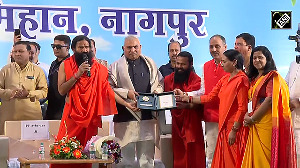This time there has been a rather peculiar criticism of the latest GDP numbers.
 Gross domestic product (GDP) data released on Tuesday by the Central Statistical Office (CSO) showed India's economy grew at a robust 7.9 per cent in the fourth quarter of the previous financial year.
Gross domestic product (GDP) data released on Tuesday by the Central Statistical Office (CSO) showed India's economy grew at a robust 7.9 per cent in the fourth quarter of the previous financial year.
While CSO's previous estimates of GDP growth under the new series have been met with scepticism about the performance of the manufacturing sector, this time there has been a rather peculiar criticism of the latest GDP numbers.
It revolves around a sharp increase in an item on the expenditure side: Discrepancies.
They grew at an alarming pace - from Rs 29,933 crore in the fourth quarter of 2014-15 to Rs 1,43,210 crore in the corresponding period of 2015-16.
Discounting these would lower GDP growth for the fourth quarter from 7.9 per cent to a mere 3.9 per cent.
The problem with this criticism is that it doesn't take into account the manner in which GDP is estimated in India.
"To begin with, estimates of gross value added (GVA) are arrived from the production side," says Pronab Sen, former chairman, National Statistical Commission.
This implies the estimates of GVA added by agriculture, industry and services are used to arrive at consolidated estimates of GVA at the aggregate level.
To these estimates, net indirect taxes - that is basically indirect taxes less subsidies - are added to arrive at consolidated estimates of GDP.
There is paucity of data on a quarterly basis on the expenditure side. Relatively reliable and timely data is available only on three items, namely "government final consumption expenditure, gross fixed capital formation (GFCF) and net exports, basically exports minus imports", says Sen.
Of these three items, government consumption expenditure is also not a precise estimate, as information at the state government level is not readily available.
But for private final consumption expenditure (PFCE), which accounts for roughly 60 per cent of GDP, data is rather sketchy.
CSO, thus, estimates this based on consumer goods and services data. Further, while estimates of change in stocks are taken from corporate results, these, too, are subject to sharp revisions.
Thus, accurate GDP estimates on the expenditure side are not available on a quarterly basis.
 The balance between GDP estimated through the production side and that estimated through the expenditure side is then apportioned to discrepancies.
The balance between GDP estimated through the production side and that estimated through the expenditure side is then apportioned to discrepancies.
'Discrepancies' is, hence, a residual entry. It's not that GDP growth is boosted because of it.
Senior economist from ICRA, Aditi Nayar, says, "Discrepancies refer to the residual that remains after disaggregating GDP into its expenditure components, such as private and government expenditure and investment."
"A larger than normal discrepancy figure in a particular quarter may be a precursor to subsequent revisions in the growth of the expenditure components and not necessarily a sizable revision in the GDP growth figure itself."
"The two estimates are unlikely to tally as these are based on different methodologies," says Madan Sabnavis, chief economist, CARE.
Over the course of the year, as more information on change in stocks is gathered through the Annual Survey of Industries data and more is known about PFCE and GFCF, these data points are revised and the level of discrepancy actually goes down.
Further, the alignment between GDP estimates from the two methods is carried out at current prices rather than at constant prices.
In current prices, the level of discrepancies has actually come down from Rs 40,206 crore in 2013-14 to Rs 9,135 crore in 2015-16.












 © 2025
© 2025